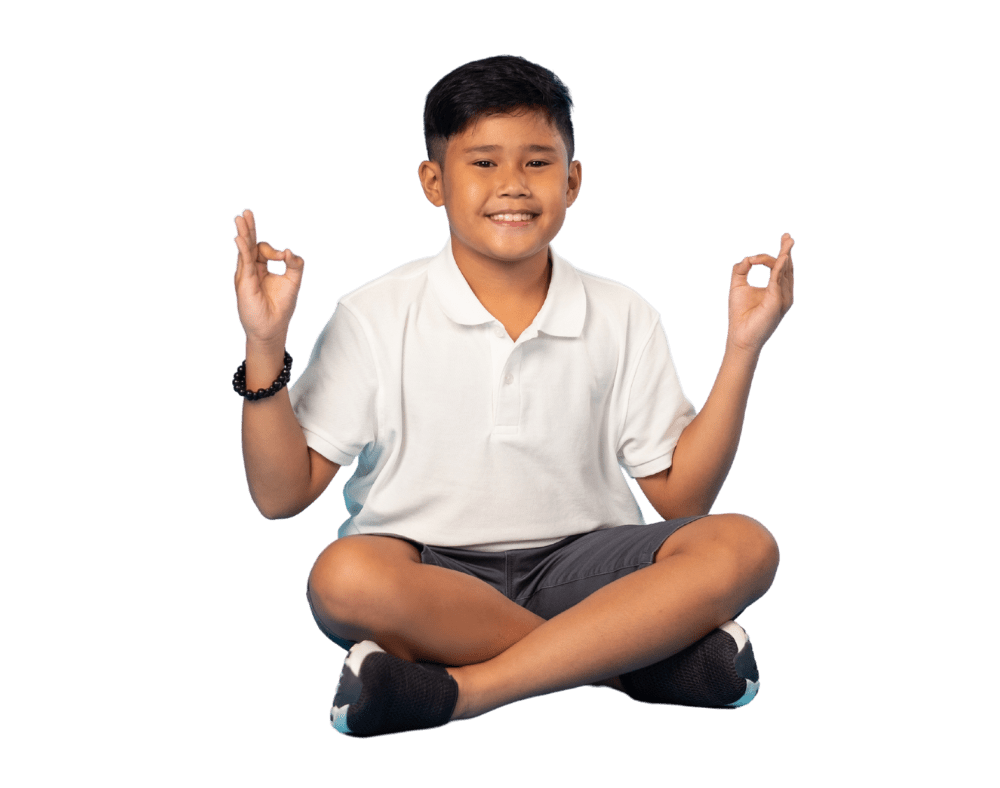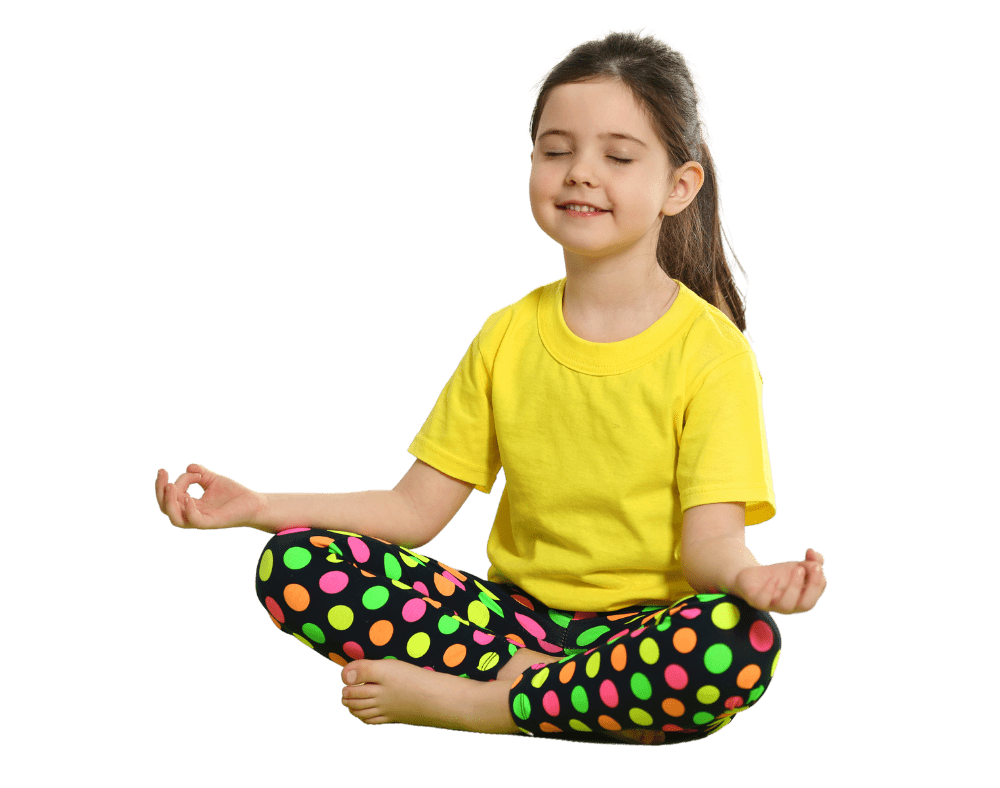One of the things that drew me most to the Kidding Around Yoga training (besides all of the awesome music) was that they offer a complete yoga practice in each and every class. So many studios and classes that offer “Yoga” focus only on the physical aspect of the practice. Yoga is so much more than the physical postures (or asanas) and it is very important that this is taught, especially to children! Not only is teaching a complete system the right thing to do, but it also makes the classes so much more fun. My students absolutely LOVE the Pranayama game, “Pom Pom Basketball,” and the Secret Garden (guided meditation) is their FAVORITE!
A long long time ago, someone named Patanjali wrote down some awesome yoga information which we now call the Yoga Sutras of Patanjali. Within this information, we can find Patanjali’s Eight Limbs of Yoga, which offers a systematic breakdown of the different aspects of a complete yoga practice. These are not linear nor a progressive path, but with continuous practice of all eight limbs, one will eventually move closer to the last aspect, which is Samadhi, or bliss (a visit to the beach during the Secret Garden maybe?!).
The Eight Limbs are as follows:
- Yama: moral restraints
- Niyama: observances, training, the building blocks for living a spiritual and ethical lifestyle
- Asana: Physical postures
- Pranayama: Breath control, regulation or expansion of life force
- Pratyahara: withdrawal of senses, inward flow of senses
- Dharana: Control of the mind, concentration
- Dhyana: Meditation
- Samadhi: Bliss, contemplation, absorption
My focus here will be on the first and second limbs, Yama and Niyama, and how we can teach these to kids in a fun and informative way.
The Yamas are focused on one’s behavior in a social context. They include; nonviolence, truthfulness, non-stealing, control of indulgent energy, and non-greed or grasping. In a Children’s Yoga class, these can be taught simply and often just through conversation. I will give a couple of ideas of how to teach the Yamas to the kids in your life.
Nonviolence is essentially not causing pain. Some attribute this Yama to mean non-killing, but himsa means to cause pain and ahimsa means not to cause pain. We can teach children about how our thoughts, words, and actions can cause pain for ourselves and others. This is a very important principle to teach, and one that can be taught by encouraging children to use affirmations with themselves and others. They can learn to change their negative thought patterns brought on by stressful situations, the pressure to succeed, and peer relationships.
Truthfulness is something that ideally all children are taught throughout their lives by their parents, but we can teach it one step further in Kids’ Yoga. Mark Twain said, “if you tell the truth you don’t have to remember anything”, and this is so true. Teach the kids that telling the truth is not only right, but it’s so much easier than remembering the lies they have told. A game could be taught, similar to “telephone” where one kid whispers a word to the next and that kid whispers the same word but adds another, and so on until there are so many words that it becomes hard to remember them all. This will help demonstrate that it is so much easier and FEELS so much better to just stick with the simple truth.
Non-stealing is a good one to teach while the “Talking Stick” is out. If one child speaks while another has the Talking Stick, we can remind them that by interrupting, they are “stealing” the other child’s time to speak.
Can you think of ways to teach the other Yamas? How about more ideas to teach Nonviolence, Truthfulness, and Non-stealing?
The Niyamas are about one’s inner life—their personal behavior towards themselves. These include Purity, Contentment, Self-Discipline, Self-Study, and Awareness Of and Surrender To God or Humanity (Higher Consciousness). Here are some ways to begin to teach the Niyamas in your classes.
Purity refers to keeping our bodies and surroundings neat and tidy. The first thing that comes to mind in regards to the KAY classes is the “Shmat” or shoe mat where the children mindfully place their shoes as they come into the class area. Keeping our things in order helps keep our minds in order too!
Contentment will likely be taught as certain situations arise in class, such as a child’s disappointment if a certain game or song is not included in that day’s class. We can use this opportunity to teach the child to be happy with what they have, instead of caving in and giving them everything that they ask for. This is also a great one to teach around birthdays and holidays.
Self-Discipline is so very important to teach to kids. By helping them set small goals and achieving them, they can learn to commit to something “doable” and stick to it until they have success. These can be tiny things such as committing to keeping their hands to themselves during the Secret Garden and achieving their goal.
Self-Study, or study of self and spiritual texts, seems like something that is too “deep” to get into in Kids’ Yoga, but that just isn’t true. An example of this can be realizing how what they think and talk about gets spread to the world. It is also a great way to practice inclusiveness of spiritual practice, no matter the worship style, background or heritage of the child. It is a way of encouraging children to pursue the discipline they may be taught at home in their daily lives. It can be as simple as challenging kids to show their friends the Peace Begins With Me meditation, or to listen to the KAY music at home. By adding simple practices and study they will be flooding their minds with such goodness that it will radiate through them to the rest of the world.
The last Niyama can also be called “dedication to God” and it refers to holding your awareness on a higher consciousness. This one is a little harder to grasp at a young age (or any age for some people!), but we can teach it through offering explanation about the word and meaning behind “Namaste.” By teaching kids to see and recognize the good (or God depending on where you are teaching) in everyone, they are learning to love and be compassionate. Another way to teach it can be as simple as reminding them there are times we must surrender to a greater will than our own: parents, teachers, bosses (as they get older), coaches, and the law. This teaches a healthy reverence and respect for those who have been placed in positions of greater authority than themselves.
Kids’ Yoga is super fun and might seem to some as just a way to “blow off steam”. It sure is a great way to burn extra energy, and it is so much more. As a KAY teacher, you have the opportunity to change your students’ lives by teaching them some of the most fundamentally important lessons they will learn. By including the Yamas and the Niyamas in your classes, you are giving your students a huge leg up in life!



